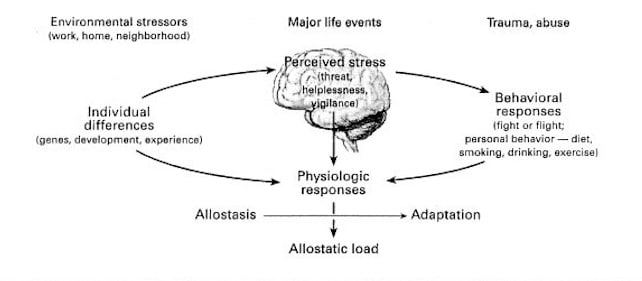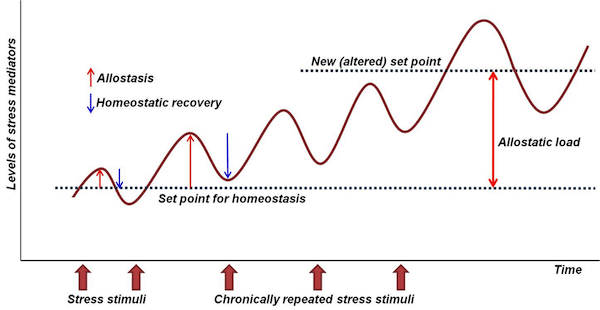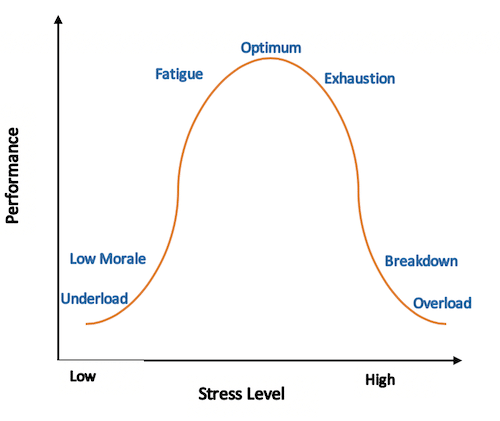Allostatic Rejuvenation: What is it, and Why you need it

Allostatic rejuvenation is your key to aging well and extending your healthspan, because it addresses the primary drivers of biochemical system dysregulation. Learn what it is and what to do.

To be clear, this is not referring to stress, as in, OMG, I left my cell phone on top of the mailbox; rather, it’s the consistent, long-time exposure to various physiological and cognitive assaults on your body and mind as you age. Conceptually, this can be referred to as “allostatic load.”
So, why should you care about allostatic load?
Because whether you know it or not, you already are or will experience it, and if you want to extend your healthspan, learning how to put yourself into a state of allostatic rejuvenation will be very helpful.
Here’s what we’re going to cover:
- What is allostasis
- Allostasis, resilience, and homeostasis: Understanding the interplay in aging
- Real-Life Examples of Allostasis, Resilience, and Homeostasis
- Allostatic Rejuvenation — The Biochemical Systems
- Your takeaway
Let’s dig in…
What Is Allostasis?

Allostasis refers to the process by which the body maintains stability through change, involving adaptive mechanisms that help an individual respond to stress and maintain homeostasis.
Simply put, allostatic load occurs when energy demand exceeds energy supply:
- Energy demand refers to the biological and physiological requirements of an individual, such as maintaining body temperature, supporting metabolic processes, and performing physical activities.
- Energy supply refers to the availability of resources that provide energy to the body from food, stored energy (such as glycogen and fat), and other metabolic pathways.
A mismatch between energy demand and supply (allostatic load) activates biological survival mechanisms that redirect an individual away from normal life stages into survival mode. If survival mode is chronic, the individual’s health deteriorates.
Allostasis consists of the body’s adaptive mechanisms that anticipate needs and prepare for change. It involves continuously adjusting physiological processes to maintain stability in response to environmental demands and stressors.
It involves alterations in hormones (such as those from the hypothalamic-pituitary-adrenal axis), the autonomic nervous system, cytokines, and other systems.
Allostasis incorporates both external and internal stressors
Allostasis is a relatively new concept, not only to me, but to the biological sciences as well.
The groundwork for allostasis can be traced back to the work of Claude Bernard in the 19th century. He emphasized the body’s ability to maintain a stable internal environment (homeostasis), but there was a shift in focus when in 1988 Peter Sterling and Joseph Eyer coined the term “allostasis, derived from the Greek words “allo” meaning “variable” and “stasis” meaning “stable state.”
The shift of focus embodied in the concept of allostasis was to achieve stability, or homeostasis, through physiological or behavioral changes. It involves the adaptation of the body’s various systems to meet the demands imposed by both external and internal stressors, as opposed to just internal factors characteristic of homeostasis.
Sterling and Eyer observed that focusing solely on maintaining a rigid set point (homeostasis) might not fully explain physiological changes during stress adaptation, leading them to propose allostasis as a model that acknowledges the body’s need to adjust and use various physiological systems (like the HPA axis, your body’s primary way to handle stress) to maintain stability in response to challenges.
I discovered allostasis when researching the last chapter of an “anti-aging” course I’m working on, which addresses the components of allostasis. This allostasis chapter is one of three within the module I’m calling “Reset”, the other two chapters covering sleep and detoxification.
(If you want to be alerted when the course launches, become a Subscriber.)
I was already familiar with resilience and homeostasis, but neither were broad enough to capture what I wanted; allostasis was.
Let’s compare allostasis, resilience and homeostasis, and then I’ll tell you why allostasis is the better lens to view the challenges of the aging phenotype.
Allostasis, resilience, and homeostasis: Understanding the interplay in aging

I’m going to quickly go over the definitions and various attributes of allostasis, resilience and homeostasis, and then review examples of how you might experience each of these.
Allostasis:
- Definition: Allostasis refers to the body’s adaptive mechanisms that anticipate needs and prepare for change. It involves constantly adjusting to new circumstances.
- Purpose: Allostasis aims to re-establish stability in response to challenges. It involves alterations in hormones (such as those from the hypothalamic-pituitary-adrenal axis), the autonomic nervous system, cytokines, and other systems.
- Dynamic Balance: Unlike homeostasis, which maintains a single set point (e.g., blood glucose level), allostasis maintains a more dynamic balance by using a collection of physiological reactions.
- Dynamic Adaptation: Allostasis focuses on the body’s ability to anticipate and adapt to changing environmental demands. This dynamic approach is crucial for aging, where the body’s requirements and stressors constantly evolve.
- Stress and Adaptation: Allostasis incorporates the concept of allostatic load, which is the cumulative burden of chronic stress and life events on the body. Understanding allostatic load is vital for aging as it accounts for how prolonged stress affects health and cognitive function.
- Integration of Multiple Systems: Allostasis involves the integration and regulation of multiple bodily systems (e.g., cardiovascular, neuroendocrine) to achieve stability through change. This holistic approach is crucial for understanding aging, which affects multiple physiological systems simultaneously.
- Brain Function and Cognitive Aging: Allostasis emphasizes the brain’s role in predicting and responding to stressors, highlighting its importance in cognitive aging. The brain’s adaptive mechanisms are crucial for maintaining cognitive function in the face of age-related changes.
Resilience:
- Definition: Resilience refers to an individual’s ability to bounce back from adversity, stress, or trauma. It’s the capacity to adapt positively to challenging situations.
- Adaptation and Recovery: Resilience involves adapting to stressors and recovering from them. It’s about maintaining psychological and emotional well-being even in the face of difficulties.
- Psychological Aspect: Resilience primarily relates to mental and emotional strength rather than physiological balance.
- Limitations Compared to Allostasis: Resilience typically refers to the ability to recover from stress, but it doesn’t fully explain the ongoing adjustments and the cumulative impact of stress over a lifetime. While it might describe cognitive reserve and recovery, it doesn’t account for the proactive adjustments the brain makes in anticipation of future stressors.
Homeostasis:
- Definition: Homeostasis is the state of maintaining a steady internal environment within a living organism. It keeps various conditions (e.g., blood sugar level, body temperature, fluid balance) at their optimal values.
- Feedback Mechanisms: Homeostasis relies on negative feedback loops to maintain stability. These loops reverse changes to bring values back to normal.
- Set-Point Regulation: Unlike allostasis, which dynamically adjusts, homeostasis aims to keep physiological parameters constant around specific set points.
- Limitations Compared to Allostasis: Homeostasis emphasizes maintaining stability within fixed parameters, which might not adequately address the adaptive changes needed as the body ages. It tends to focus on individual parameters (e.g., blood pressure, body temperature) rather than the integrated functioning of different systems.
In summary, allostasis offers a richer, more adaptive framework for understanding aging by focusing on the body’s and brain’s ability to dynamically respond to and anticipate stressors, integrating multiple systems, and accounting for the cumulative impact of stress over time. This makes it a more effective conceptual tool than homeostasis or resilience alone.
By understanding the interplay between the immune-endocrine regulatory system, thymic involution, and HPA axis dysregulation, we gain insight into how these processes collectively impact hormonal balance and overall health, particularly as we age. This integrated approach is essential for developing strategies to enhance healthspan and improve quality of life.

Allostasis Rejuvenation: Adapting to change and maintaining dynamic balance
Job Promotion: You get a job promotion that comes with increased responsibilities and higher stress levels.
- Allostatic Response: Your body anticipates the need for higher cognitive function and stress management. The HPA axis is activated, leading to increased cortisol production, which helps to maintain alertness and energy levels. The autonomic nervous system also adjusts, increasing heart rate and blood pressure to meet the demands.
- Dynamic Balance: Over time, the body adapts to the new stress levels. If the stress is managed well, the person will develop new routines and coping mechanisms, maintaining productivity without long-term negative effects.
Regular Physical Exercise: You start a new, intensive exercise program.
- Allostatic Response: Initially, the body experiences increased heart rate, blood pressure, and muscle breakdown. The endocrine system releases adrenaline and cortisol to provide energy and manage inflammation.
- Dynamic Balance: With consistent training, the body adapts by improving cardiovascular efficiency, increasing muscle mass, and reducing resting heart rate. This adaptation enhances overall fitness and resilience to physical stress.
Resilience: Mental and emotional strength
Recovering from Personal Loss: You lose a loved one and experience a period of intense grief.
- Resilience Response: Despite the emotional pain, you utilize coping mechanisms such as talking to friends, engaging in hobbies, and seeking professional help if necessary. Over time, you begin to adapt to the loss and find ways to carry on with life.
- Adaptation and Recovery: You develop emotional strength and the capacity to find meaning and joy in life again, demonstrating resilience by not being overwhelmed by adversity.
Facing a Career Setback: You have a significant career setback, such as being passed over for a promotion or losing their job.
- Resilience Response: They initially feel disappointment and stress but eventually start to seek new opportunities, learn new skills, and network with professionals. They maintain a positive outlook and persevere despite the challenges.
- Psychological Strength: The ability to adapt to the setback, maintain self-esteem, and pursue new goals illustrates resilience, helping the person to grow stronger and more capable of handling future challenges.
Homeostasis: Maintaining Steady Internal Conditions
Regulating Body Temperature: You’re exposed to a cold environment.
- Homeostatic Response: The body initiates mechanisms to maintain core temperature, such as shivering to generate heat and constricting blood vessels in the skin to reduce heat loss.
- Set-Point Regulation: These actions help to keep the internal body temperature around the optimal set point (approximately 37°C or 98.6°F) despite external temperature changes.
Blood Sugar Regulation: After eating a meal high in carbohydrates, your blood sugar levels rise.
- Homeostatic Response: The pancreas releases insulin, which facilitates the uptake of glucose by cells, reducing blood sugar levels back to the normal range.
- Set-Point Regulation: This feedback loop ensures that blood glucose levels remain within a narrow range, preventing hyperglycemia or hypoglycemia.
Those examples illustrate how allostasis, resilience, and homeostasis operate in real-life scenarios.
- Allostasis is seen in how the body and mind anticipate and adapt to new challenges, maintaining a dynamic balance through physiological and behavioral changes.
- Resilience is demonstrated through the capacity to recover from adversity, maintaining mental and emotional well-being.
- Homeostasis involves maintaining steady internal conditions, using feedback mechanisms to keep physiological parameters within optimal ranges.
Understanding these processes provides a basic understanding about how the body maintains health and stability in the face of various stressors and changes.
But what’s going on from a biochemical systems level, and what can we do to help slow down or reverse the degradation of those systems as we age?
I’ll address that next.
Allostatic Rejuvenation — The Biochemical Systems
Now we’re going to delve into the primary biochemical systems that are involved in allostasis. These systems degrade as we age, and thereby contribute to “allostatic load”
What is allostatic load?

The concept of allostatic load was introduced by the researchers Bruce McEwen and Eliot Stellar in the 1990s. It proposes that the repeated cycles of physiological adaptation to stressors over time can lead to a state of dysregulation and overexposure to mediators like cortisol, cytokines, and other biomarkers of stress.
This chronic over-activation and inability to return to baseline levels after a stressful event can contribute to the development of various age-related diseases, such as cardiovascular disease, metabolic disorders, cognitive impairment, and immune dysfunction.
Allostatic load is often measured through a composite index that takes into account various biomarkers related to the functioning of the immune-endocrine regulatory system, hypothalamic-pituitary-adrenal (HPA) axis, metabolic processes, cardiovascular system, and immune system (thymus).
Higher allostatic load scores indicate a greater cumulative physiological burden and increased risk of adverse health outcomes.
The concept of allostatic load provides a framework for understanding how chronic stress and the dysregulation of adaptive physiological systems can contribute to the pathogenesis of age-related diseases and accelerated aging processes.
With that framework in mind, let me tell you about the primary systems that contribute to allostatic load as we age, which are:
- The Immune-Endocrine Regulatory System,
- Thymic Involution, and the
- HPA Axis
These three systems explain much of what contributes to allostatic load as we get older. I’ll explain each of them, how they interconnect and how to reduce your allostatic load as you age.
The Immune-Endocrine Regulatory System

The immune system, primarily responsible for defending the body against pathogens, is deeply influenced by the endocrine system, which regulates hormones and thus affects numerous physiological processes. This interaction is bidirectional:
- Hormones and Immune Function:
- Hormones such as cortisol, produced by the adrenal glands via the HPA axis, directly influence immune responses. High levels of cortisol, often due to chronic stress, suppress immune function, making the body more susceptible to infections.
- Sex hormones like estrogen and testosterone also modulate immune responses. Estrogen, for example, has anti-inflammatory properties, while testosterone generally suppresses immune activity.
- Immune Signals and Endocrine Function:
- Cytokines produced during immune responses can affect the HPA axis, altering cortisol production. Chronic inflammation can lead to sustained high cortisol levels, impacting various hormonal pathways.
Thymic Involution: Immune and Endocrine Impacts

The thymus gland is a critical component of the immune system, responsible for producing and maturing T cells, which are crucial for adaptive immunity. However, the thymus undergoes progressive involution (shrinkage) starting in early childhood, leading to a decline in T cell production and immune function.
This shrinkage, known as “thymic involution”, is linked to increased susceptibility to infections, autoimmune disorders and certain cancers, and has significant implications for both the immune and endocrine systems:
Immune System Decline:
- Thymic involution leads to a decrease in the production of new T cells, contributing to immunosenescence. This reduced immune capability increases the risk of infections, cancers, and autoimmune diseases in the elderly.
- A weakened immune system can trigger chronic inflammation, further straining the body’s allostatic balance.
Endocrine System Interference:
- The thymus produces thymosins, which influence endocrine functions. As thymic function declines, these hormonal influences wane, potentially disrupting the balance of other hormones.
- Chronic inflammation resulting from immunosenescence can impair the HPA axis and the hypothalamus-pituitary-gonadal (HPG) axis, leading to hormonal imbalances such as decreased testosterone and estrogen levels.
Strategies to Support Thymic Function:
- Nutrition: Diets rich in antioxidants, vitamins (A, D, E), and minerals (zinc, selenium) can support thymic health and reduce inflammation.
- Exercise: Regular physical activity enhances immune function and may slow thymic involution.
- Potential Regenerative Therapies: Hormone therapies (growth hormone, thymic peptides), stem cell therapies, and interventions to reduce chronic inflammation show promise in supporting thymic function.
HPA Axis Dysregulation: Stress and Hormonal Imbalances

When the brain perceives a stressor, the hypothalamus releases corticotropin-releasing hormone (CRH), which signals the pituitary to produce adrenocorticotropic hormone (ACTH). ACTH then stimulates the adrenal glands to release cortisol, the primary stress hormone.
Cortisol has widespread effects throughout the body, including:
- Increasing blood sugar levels for energy
- Suppressing non-essential functions like digestion and reproduction
- Regulating inflammation and immune response
While acute stress responses are adaptive, chronic stress can lead to HPA axis dysregulation, characterized by persistently elevated cortisol levels. This has profound effects on the immune and endocrine systems:
Chronic Stress and Immune Suppression:
- Prolonged activation of the HPA axis elevates cortisol levels, which suppress immune function, making the body more vulnerable to infections and diseases
- This suppression further exacerbates thymic involution and immunosenescence, creating a vicious cycle of immune decline and increased stress response.
Impact on Sex Hormones:
- High cortisol levels inhibit the secretion of gonadotropin-releasing hormone (GnRH) from the hypothalamus, leading to reduced levels of luteinizing hormone (LH) and follicle-stimulating hormone (FSH). This results in lower production of testosterone and estrogen.
- Dysregulation of the HPA axis can disrupt sleep, metabolism, and mood, all of which are critical for maintaining hormonal balance and overall health.
Strategies to Mitigate HPA Axis Dysregulation:
- Stress Management: Techniques like mindfulness, meditation, yoga, and deep-breathing exercises reduce stress and lower cortisol levels.
- Adaptogens: Herbs such as ashwagandha, rhodiola, and ginseng help modulate the stress response.
- Lifestyle Modifications: Ensuring adequate sleep, engaging in regular physical activity, and maintaining social connections support HPA axis function.
Interconnection and Impact on Hormones
The thymus gland and the HPA axis are not isolated systems but are interconnected in ways that influence the overall endocrine balance, particularly sex hormones. The immune-endocrine regulatory system exemplifies this connection, where both immune health and hormonal health are maintained through allostasis:
Bidirectional Influence:
- Chronic stress (HPA axis dysregulation) can lead to elevated cortisol, which suppresses thymic function and accelerates thymic involution, weakening the immune system.
- Immunosenescence (from thymic involution) increases chronic inflammation, which further disrupts the HPA axis, perpetuating a cycle of stress and immune decline.
Hormonal Imbalances:
- Thymic involution and chronic stress reduce the levels of sex hormones. In men, this means lower testosterone levels, affecting muscle mass, libido, and mood. In women, reduced estrogen levels can lead to symptoms of menopause, decreased bone density, and mood swings.
Integrative Strategies to Mitigate Allostatic Load:
- Optimizing Nutrition: Eating a balanced diet rich in essential nutrients and antioxidants supports immune and endocrine health.
- Regular Exercise: Both aerobic and resistance training activities boost immune function and hormone levels, enhancing overall resilience.
- Stress Management: Mindfulness, meditation, and other relaxation techniques reduce stress and lower cortisol levels, supporting both thymic and HPA axis function.
- Adaptogens and Supplements: Adaptogenic herbs and supplements like magnesium, vitamin C, and B-complex vitamins support adrenal health and stress resilience.
- Regenerative Therapies: Hormone replacement, thymic peptides, and other regenerative therapies may help restore thymic function and optimize hormone levels, under medical supervision.
Your Takeaway
Understanding the interplay between the immune-endocrine regulatory system, thymic involution, the HPA axis dysregulation and all their downstream effects provides insight into how these systems collectively impact hormonal balance and overall health, particularly as we age.
These biochemical systems are tied together not only systemically via how they affect each other, but conceptually given that they collectively are the most prominent systems that define allostasis.
Through the lens of allostasis, we see that maintaining physiological resilience requires a comprehensive approach that addresses nutrition, exercise, stress management, and potential regenerative therapies. By supporting these interconnected systems, you can mitigate allostatic load, improve their healthspan, and enhance their quality of life.
So, as I always do, I encourage you to:
- Regularly engage in the three-leg stool of exercise: mobility, cardiorespiratory and strength training;
- Eat plenty of plant food to get the needed phytonutrients and fiber;
- Become mindful of your stress level and endeavor to lower it;
- Consider taking the adaptogens, vitamins and minerals mentioned above; and
- If needed, talk to your doctor about the regenerative therapies mentioned above.
Oh, one more thing… if you haven’t already, subscribe!
Last Updated on June 2, 2024 by Joe Garma


